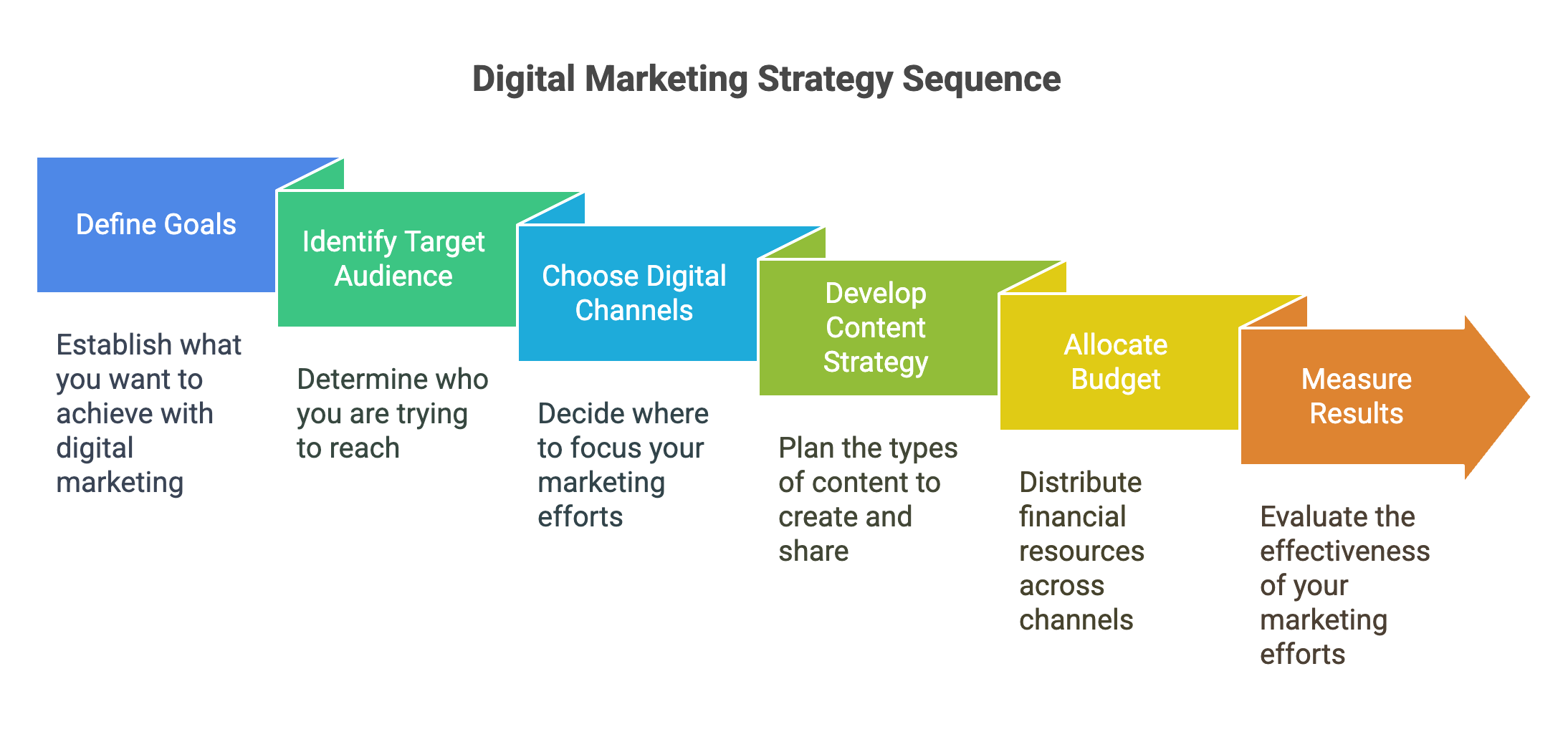Digital Marketing Strategy
Introduction to Digital Marketing Strategy
A digital marketing strategy is like a roadmap for your online marketing efforts. It's a plan that outlines how you'll use digital channels like search engines, social media, email, and content marketing to achieve your specific marketing goals.
Think of it this way: you wouldn't set off on a road trip without a map, would you? Similarly, a digital marketing strategy helps you navigate the online world and reach your desired destination.
Why is a Digital Marketing Strategy Important?
- Provides Direction: It gives your efforts focus and ensures everyone on your team is working towards the same goals.
- Maximizes ROI: By identifying the most effective channels and tactics, you can allocate your budget wisely and get the most out of your investments.
- Enhances Brand Consistency: It helps you create a cohesive brand experience across all your digital touchpoints.
- Facilitates Measurement and Optimization: A clear strategy allows you to track your progress, measure results, and make data-driven adjustments.
Key Components of a Digital Marketing Strategy:
-
Define Your Goals:
What do you want to achieve with your digital marketing efforts? Examples:
- Increase brand awareness: Get more people to know about your brand.
- Generate leads: Capture contact information of potential customers.
- Drive website traffic: Attract more visitors to your website.
- Boost sales: Increase online or offline sales.
-
Identify Your Target Audience:
Who are you trying to reach?
- Demographics: Age, gender, location, income, education, etc.
- Psychographics: Interests, values, lifestyle, behaviors, etc.
- Online behavior: What websites do they visit? What social media platforms do they use?
-
Choose Your Digital Channels:
Where will you focus your efforts?
- Search engine optimization (SEO): Improve your website's visibility in search results.
- Content marketing: Create and share valuable content to attract and engage your audience.
- Social media marketing: Connect with your audience on social media platforms.
- Email marketing: Nurture leads and build relationships through email campaigns.
- Paid advertising: Use online ads to reach a wider audience.
-
Develop a Content Strategy:
What kind of content will you create and share?
- Blog posts: Share informative and engaging articles.
- Videos: Create visually appealing content that tells your brand's story.
- Infographics: Present data and information in a visually compelling way.
- Social media updates: Share engaging posts that encourage interaction.
-
Allocate Your Budget:
How much will you spend on each channel and tactic?
-
Measure Your Results:
Track your progress and adjust as needed.
Example:
Imagine a small online clothing store targeting young adults interested in sustainable fashion. Their digital marketing strategy might include:
- Goal: Increase online sales by 20% in the next quarter.
- Target audience: Young adults (18-35 years old) interested in eco-friendly clothing, ethical production, and minimalist style.
- Channels: Instagram, Pinterest, email marketing, and SEO.
- Content: High-quality photos of their clothing, blog posts about sustainable fashion, and behind-the-scenes looks at their ethical production process.
- Measurement: Track website traffic, sales conversions, and social media engagement.
By following a well-defined digital marketing strategy, businesses can effectively reach their target audience, achieve their marketing goals, and thrive in the competitive online landscape.
The 7Ds and 5Ss of Digital Marketing
These two frameworks provide valuable lenses for understanding and structuring your digital marketing efforts. They offer a holistic view of the digital landscape and help you align your activities with your overall business goals.
The 7Ds of Digital Marketing
This framework emphasizes the key aspects to consider when developing and implementing a digital marketing strategy:
-
Digital Goals: Clearly define what you aim to achieve through digital marketing. Are you looking to increase brand awareness, generate leads, drive sales, or improve customer engagement?
-
Digital Audiences: Understand your target audience's online behavior, preferences, and needs. This allows for tailored messaging and content that resonates.
-
Digital Devices: Recognize the diverse devices your audience uses to access the internet (smartphones, tablets, laptops, desktops). Optimize your digital presence for a seamless experience across all devices.
-
Digital Platforms: Identify the online platforms where your target audience spends their time (social media, search engines, websites, forums). Focus your efforts on the platforms that will yield the greatest reach and engagement.
-
Digital Media: Utilize various digital media formats to engage your audience. This includes text, images, videos, audio, and interactive content.
-
Digital Data: Leverage data analytics to track your progress, measure results, and gain insights into your audience's behavior. This allows for data-driven decision-making and optimization.
-
Digital Technology: Embrace new and emerging technologies to enhance your digital marketing efforts. This could include AI, machine learning, and automation tools.
The 5Ss of Digital Marketing
This framework focuses on the key goals and objectives of digital marketing:
-
Sell: Drive revenue and increase sales through digital channels. This involves optimizing your website for conversions, running targeted ads, and leveraging social media for product promotion.
-
Serve: Provide exceptional customer service in the digital realm. This includes responding to queries promptly, offering online support, and creating helpful content that addresses customer needs.
-
Speak: Engage in two-way communication with your audience. This involves listening to feedback, responding to comments and messages, and fostering online communities.
-
Save: Reduce costs through digital marketing efforts. This could involve automating tasks, using online channels for customer support, and optimizing your marketing spend.
-
Sizzle: Extend your brand online and enhance its appeal. This includes creating engaging content, building a strong online presence, and offering unique digital experiences.
By considering both the 7Ds and 5Ss, businesses can:
Develop a comprehensive digital marketing strategy.
Align their digital activities with their business goals.
Effectively reach and engage their target audience.
Maximize their return on investment.
Stay ahead of the curve in the ever-evolving digital landscape.

